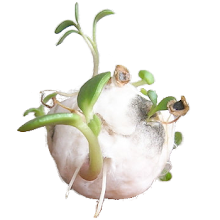Did you know that about one-third of our bees nationwide have disappeared in just the last few years? Since bees pollinate almost all our food crops and flowers, we are in a good amount of trouble should this downward trend continue. Lately, I have been thinking a lot about bees and everything that is happening to hurt their populations: pesticides, cell phone towers, lack of wildflowers, genetically-modified foods. I don't use pesticides and I don't buy GMO foods, but I can do something about wildflowers.
I came up with a new product idea for my shop: a line of special edition seed bombs in yellow and black (the color of bees, of course, but also because black and yellow are two of the six colors that honeybees recognize) with a premium mix of seeds in them that attract bees with long-blooming, colorful flowers. Honey bees prefer single petal blossoms like Daisies, Black-eyed Susan, and Echinacea because single petal flowers produce more pollen and nectar than double or triple blossom flowers. (By the way, this mixture also attracts hummingbirds and butterflies!)
https://www.etsy.com/listing/76355971

This mixture contains 19 wildflowers: 11 annuals for first-year color, plus 8 perennials for second and successive years' bloom. The seeds are good for growing zones 1-8, which includes the Northeast, Southeast, Midwest, Southwest, West, Pacific NorthWest. Here's what you and your neighborhood bees will get: Shasta Daisy, Lance-Leaf Coreopsis, Plains Coreopsis, Wild Cosmos, Sulphur Cosmos, Purple Coneflower, Dwarf Sunflower Sunspot, Sweet Alyssum, Lacy Phacelia, Yellow Prairie Coneflower, Mexican Hat, Black-eyed Susan, African Marigold, Strawberry Clover, Crimson Clover, White Dutch Clover, Zinnia.
I am so excited to offer this new product and do something good for the earth and for mankind. My seed bombs are also made from recycled scrap paper and hopefully their use will help bees pollinate our food crops while recycling biodegradable paper. I did a little internet research when I was first thinking about this idea and found so many interesting tidbits about bees:
* There are over 12,000 species of bees, but only about 600 of them are social in habit. Among the social bees are the honeybee (or hive bee) and the bumblebee. The bumblebee is round and furry and moves around slowly. The honeybee has a more streamlined body and moves around much faster (about 15 miles/hour).
* The weather often affects the temper of bees. On windy and cloudy days, when they are unable to search for nectar and pollen, bees will be more aggressive.
* Bees can't recognize the color red, but they can see ultraviolet colors.
* Honeybees fly 55,000 miles and visit 2 million flowers to produce one pound of honey.
* The only natural enemy of a bumblebee is a skunk!
* Honeybees prefer blue, purple or yellow flowers. So, plant more of those in your garden. They prefer these flowers because the colors that honeybees see are green, blue, purple, yellow and black.
* One percent of all middle-aged bees become undertakers—a genetic brain pattern compels them to remove dead bees from the hive. But most amazingly, regular honeybees—which perform multiple jobs in their lifetime—will change their brain chemistry before taking up a new gig.
* When aging bees do jobs usually reserved for younger members, their brain stops aging. In fact, their brain ages in reverse.
* Researchers have found that bumblebees fly the shortest route possible between flowers. So far, they’re the only animals known to solve a distance problem.
* Serial killers behave like bees. They commit their crimes close to home, but far away enough that the neighbors don’t get suspicious. Similarly, bees collect pollen near their hive, but far enough that predators can’t find the hive. To understand how this “buffer zone” works, scientists studied bee behavior and wrote up a few algorithms. Their findings improved computer models police use to find felons.

No comments:
Post a Comment